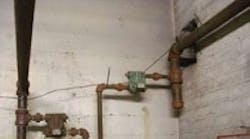Exhibit A: These hoffman F&t traps are piped down to a 3-in. line that feeds into the vacuum unit.
Exhibit B: The previous contractor neglected to put swing joints on the steam risers, neglected to re-insulate, incorrectly connected the supply main between the risers, and incorrectly used a concentric reducer on the header.
The Call
On the line was a contractor who has been a one man shop since his dad retired from the trade. He wanted to know if I would like to meet him at an historic estate that is now run as a foundation, offering the building for weddings, meetings, etc. At one time it was the largest private home, with the most land, in the wealthiest neighborhood. That's a lot of superlatives.
His idea was two-fold. He knows I'm always looking for steam heated buildings that can be used for my "hands on" training, and thought this society shack might work. He also wanted me to check out the installation by a different contractor of a new steam boiler.
I was very interested, since I hadn't been in the estate house for a long time. What I know now, I didn't know then. I vaguely remembered looking at the system with his dad years ago. Now I was curious to see how my perspective of that steam system might have changed.
The morning was rainy and foggy when I pulled up to the main house. It looked like the setting for an English mystery movie. The contractor's truck was faintly visible on the main driveway. I followed him to meet the caretakers. They have an apartment in the service wing. The boiler room is a story-anda-half below that.
The Troubleshoot
The boiler room is very large, the coal bunker even larger. There's plenty of room to have a class, and plenty of equipment to talk about. I see an older vacuum pump, a rusty boiler feed unit, and a spanking new boiler. One fed into the other that fed into the other. This is going to be fun to explain to the technicians.
Up on the wall in the corner are two float and thermostatic traps (Exhibit A). A 1-1/4-in. line is on the left, while a 2-in. line is on the right. Both reduce to 3/4-in. off the dirt leg. Those Hoffman F&T traps are piped down to a 3-in. line that feeds into the vacuum unit. It looks innocent enough, until you start looking around.
We travel through basement hallways over long distances. I notice many drip traps, with a connection to both the wet return below, and to the dry return above. It's a classic Webster two pipe gravity return system. I ask the caretaker when the house was built, even though I already guessed the answer.
"It was built in 1929" he answers.
"The Golden Age of Steam" I reply.
The condensate flows down to a no pressure wet return, while the air passes up to the dry return. This pattern repeats itself many times along our journey to the end of the supply mains. I always look for the end of steam main air removal. No air vents to be seen out here. All the air passes to that dry return.
Back in the boiler room, I ask about the two traps. Again, I thought I knew the answer, but this time I wanted to hear an explanation. The left trap acts as a drip for an elevation change of the steam main after it leaves the boiler room. There's nothing wrong with that. Maybe add a strainer on the inlet side, but it does have a dirt leg. I'll let the purists argue that point.
The right side, however, was trapping the end of the dry return. I was thinking that this is where you would normally see a Webster boiler return trap and an air eliminator. The contractor explains that he helped his dad remove a great big trap one day, and replaced it with the F&T trap.
I hope that I hadn't told his dad to do this years ago, since it can create some real problems. Back then, I probably thought that a trap was a trap. The name is confusing. A boiler return trap doesn't trap anything. Its job is to return water to the boiler. It shoves water back into the boiler if the pressure gets too high for gravity return, an important feature on a coal-fired boiler.
With this oil-fired boiler, the pressure-trol keeps the steam pressure under control while the boiler feed unit controls the waterline. No water problems with that set-up. But, by adding the trap to the end of the dry main, the radiator and drip traps are now double trapped. Usually that creates condensate return problems. However, the water content of the boiler feed tank compensates for the sluggish condensate return.
The real problem is air removal. All the air from all the steam supply mains, and all the radiators have to pass through the thermostatic element of the F&T trap. That little hole can pass around one cubic feet per minute of air. The original Webster Air Eliminator could pass around five cubic feet per minute. That can make a real difference.
The Follow-up
I took a few pictures of the new boiler installation for my HVAC Comfortech presentation coming up in St. Louis this September (www.hvaccomfortech.com). That contractor neglected to put swing joints on the steam risers, neglected to reinsulate, incorrectly connected the supply main between the risers, and incorrectly used a concentric reducer on the header (Exhibit B). That is a bad recipe for near boiler piping. At HVAC Comfortech, I'll explain why that can have an effect on efficiency, and 14 other tips for peak performance of steam systems.
The caretaker was very interested in correcting his air removal problem. The trap had to be taken out. That would be easy. The hard decision was choosing between adding lots of big main air vents or fixing the vacuum pump, which hadn't pulled a vacuum on the system for quite a few years. I haven't seen too many that still do.
Improving the air elimination rate from the steam supply piping and the radiators, another tip for peak performance, will speed up the circulation of the steam, which decreases boiler run time, which leads to lower heating bills. This time, the caretaker was ready to have the work done before I had a chance to quote the repair options to the contractor.
| Patrick Linhardt is the Hydronic Heating Division Manager at Habegger Corp. — Carrier Division in Cincinnati, OH. He oftens lends his sleuthing skills and technical expertise to local contractors in need. To order his book, Linhardt's Field Guide to Steam Heating, visit www.steamupairoutwaterback.com or call 513/703-5347. |











